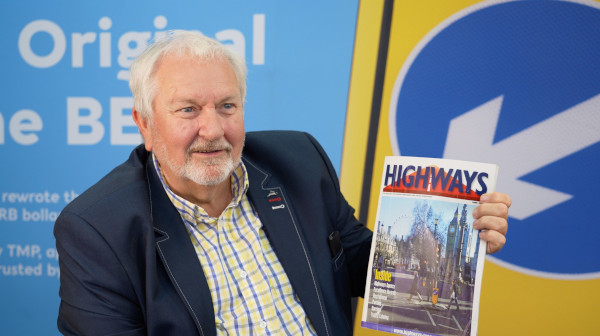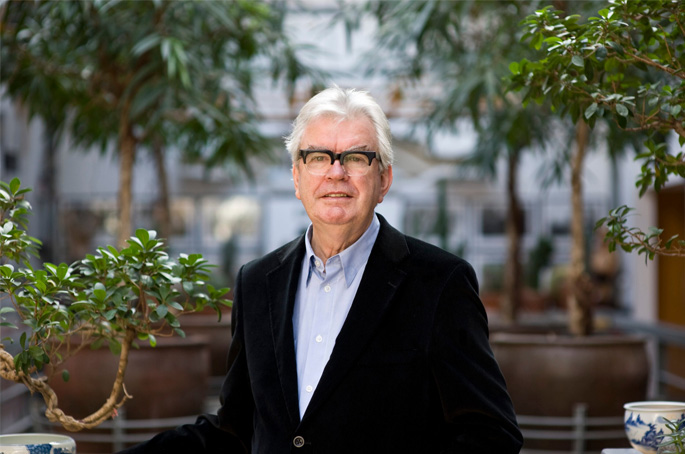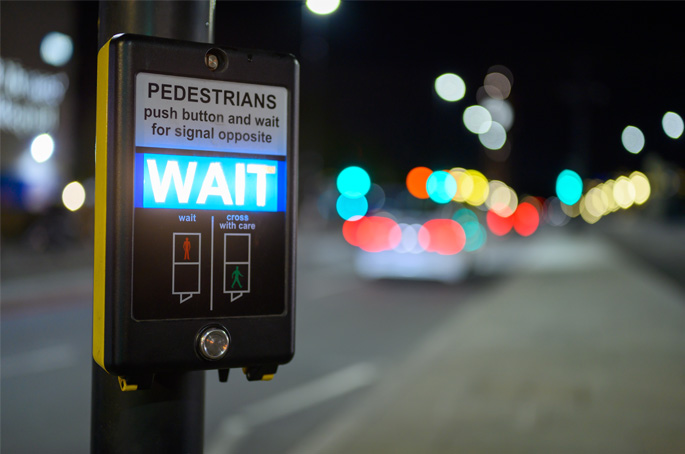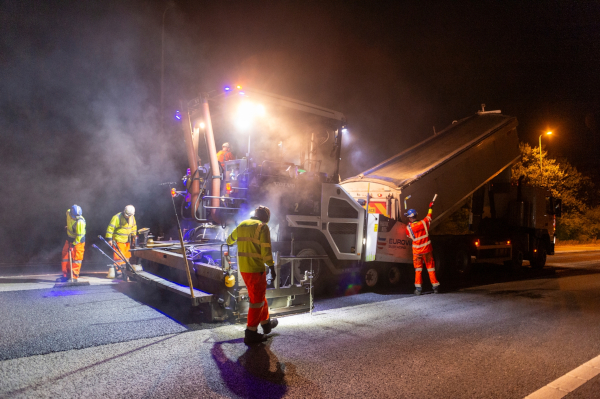The story of the Retroreflective Self-Righting Bollard (RSRB), as told by its inventor Chris Nicklin to Jonathan Brown.
Some of the biggest innovations in highways don't come from multinational R&D labs. Sometimes they're sparked in a garage by a bloke with a head torch, a piece of cardboard and a hunch that this might be a new way to build bollards.
Chris Nicklin didn't just invent the rebounding traffic bollard - he disrupted the industry, broke the regulations open and put reflective, self-righting bollards on centre islands from Westminster to Hong Kong.
Mr Nicklin visited the original manufacturers of the RSRB, Traffic Management Products Ltd (TMP) in Wednesbury last month - and the timing couldn't have been better as it marked exactly 20 years since his invention appeared on the front cover of Highways magazine.
We spent the afternoon hearing his stories, sharing a few laughs, and giving him a VIP tour of the factory. TMP might look a bit different these days but that same spark - that slightly rebellious, roll-your-sleeves-up energy - is still here, and still driving us forward.
"You're going to work with me."
Mr Nicklin's route into traffic and safety management wasn't exactly conventional. He started as a chef, then became an executive chef for Banks's Brewery and was even moonlighting as a disco DJ. A chance move into signage at Pearce Signs eventually put him on a course for TMP.
'I was working at Pearce Signs when this customer from London turned up, looking round with his PA,' Mr Nicklin recalls. 'On the way out he says, "You're going to work with me". I thought, Who is this guy?'
That bloke was Paul Daniels - not the magician - and after a couple of years of persistent calls, he and Marco Peters finally persuaded Mr Nicklin to join the fledgling TMP, a start-up with just three people based in Outwood, Surrey.
'They were fun, they were different. And I liked that. Pearce Signs had just been bought out, and it wasn't the same. I wasn't in it for the money, and when the new management team took over, we just weren't a good fit.'
So, he made the jump. At the time, TMP was selling wheel clamps and parking gear. But Mr Nicklin was already thinking a few steps ahead.
Photo: Chris Nicklin with his now famous RSRB invention.
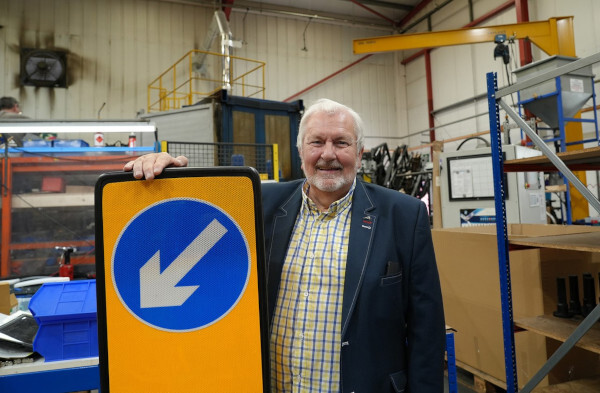
Something new in the garage
The catalyst came from the American giant 3M. It had developed a new diamond-grade reflective sheeting – florescent yellow, extremely bright - but was only marketing it for school crossings. Mr Nicklin had other ideas.
'I knew it had legs, so I glued it to a bit of cardboard in my garage, strapped a torch to my head, and said to my wife, "I've got an idea". She just rolled her eyes.'
That idea was the beginning of the RSRB - the Retroreflective Self-Righting Bollard. Mr Nicklin's prototype wasn't lit but it was incredibly visible thanks to the new sheeting. The trouble was, it didn't tick the regulatory boxes.
'I went to the Department for Transport (DfT). The current regulations said you need to light sign bollards. But when I dug into it, I realised there was nothing about opal bollards needing to be lit – not if they weren't being used as a sign and were predominantly used on the exit of a roundabout. Because you don't have to keep left – you can continue round the roundabout.'
This was the break he needed to get this new type of bollard onto the market. The DfT also agreed to trial unlit keep-left bollards (Diagram 610), as long as they were backed up with a lit keep-left sign on a post.
From one to fifty
Mr Nicklin began to push the bollards out wherever he could: 'We were selling two here, three there. Then I went to the London Borough of Lewisham and met a guy there. I told him he could put these opal bollards on all exits to roundabouts - no need for lighting, no rule against it. He says, "Really?" I said, "Absolutely". And he ordered 50 opal bollards on the spot.'
The order was a big moment for the tiny team. 'There were still only five of us. I handed the PO to Rachel, my PA. She read it and said, "Fifty?!" Everyone cheered. It was huge.'
But Mr Nicklin wasn't stopping there. 'We were still limited by where we could use the unlit version, which we called the Flecta. That was our first proper one – real basic, just bent plastic – but it did the job. What we needed next was a lit version. So we brought out the solar-powered Heritage. If it was lit, it could go anywhere – and that really opened up the market.'
Into the mainstream
Regulation was always a hurdle. Even if a local authority wanted to install the bollards, they needed permission from the DfT. Mr Nicklin found a solution.
'I created template letters for customers to copy and paste onto their letterheads to ask for permission. I even gave them stamped, addressed envelopes with the DfT's address on. That got the ball rolling.'
But councils still wanted reassurance. 'They'd say, ‘What standard does it meet?' I thought, oh Christ – a standard? So we got it tested for passive safety, BS EN 12767. Because it bends and springs back, it was ideal. I went to BSI and we got it accepted.'
As momentum built, Chris and TMP faced another challenge: visibility – not the reflective kind, but credibility. A breakthrough came thanks to a bit of luck in Westminster.
'Marco Peters had started an advertising company and had a small media office on Victoria Street. I thought I'd try to schedule a meeting with Westminster City Council – they were also on Victoria Street.
'So, I went down to Westminster City Council. I'm in reception with a bollard under my arm, and this bloke walks in and says, "What's that?" I say, "It's a new type of bollard". He says, "Come and show me it in the road". He came out with me, took a good look, and walked off.
'Two days later, the street lighting engineer I'd booked the meeting with rang me. It turned out the bloke who stopped me in reception was actually the head of transport for Westminster – and he'd asked the engineer to trial ten of the new bollards.'
But where to put them? Chris cheekily asked if they could go in Victoria Street. The engineer said, "Why not?" – so they did.
'Once the bollards were in, I went back down to London and took a photo of them with Big Ben, the Houses of Parliament and Westminster Abbey in the background – incredible photo.'
That image went viral – or at least, as viral as you could get in pre-Instagram 2000s traffic circles.
'Highways magazine stuck it on the cover. Other advertisers rang the editor, fuming. They'd paid for an ad and we got the front cover for free. They couldn't get over that.'
Competitors, patents and a red Porsche
As the concept gained traction, other firms started copying the idea. 'We patented what we could,' Mr Nicklin says, 'but you're a small company – you've got no chance in court against the big boys.'
The key post and spring mechanism came from San Antonio, Texas, via a supplier called IRS. The MD was Greg Hannah.
'We imported his base and used it in our design. We became good friends – in fact, we still email each other on our birthdays.'
Eventually, in 2006, TMP was sold to Dewhurst – a lift component company with no obvious connection to traffic products, but they were good people and saw the potential.
'We never figured out why they bought it – but I think it was because of the bollard. I was lucky – I'd been given share options because of my work, and on the day Marco and Paul sold the business, they called me in, handed me the keys to a brand-new red Porsche, and said, "That's for you". Lovely gesture.'
And yes – he still has it today.
The legacy
The RSRB is now a familiar sight on highways across the UK – tough, energy-free, reflective, and self-righting. And for every one that replaces a traditional lit shell, that's two fewer light bulbs drawing power from the grid. Over time, that's a staggering energy saving.
Yet its success was far from guaranteed. It all started with a roll of reflective film, a bit of cardboard in a garage and someone willing to challenge the status quo.
Mr Nicklin's design didn't just transform UK roads. It found its way to places like Malta and Hong Kong too, where British standards still influence local infrastructure. In cities with tight maintenance budgets and high safety demands, the bollard's durability, passive safety and zero energy use made it a smart, future-ready choice.
Mr Nicklin doesn't call himself an inventor. But his work changed the landscape of UK roads and roads overseas.
Next time you pass a bollard that bounces back, remember: it all started with a bloke in a garage and a head torch.

